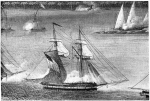Specifications:
Displacement 186 t.
Length 87'6" (overall)
Beam 23'8"
Depth of Hold 9'10"
Draft unknown
Speed unknown
Complement 103
| Click On Image For Full Size Image | Size | Image Description | Source | |
|---|---|---|---|---|
 |
185k | USS Nautilus (I) taking fire from Tripolian corsairs during the Barbery Wars. | Robert Hurst | |
 |
129k | Bombardment of Tripoli, 3 August 1804 Oil by Michael Felice Corne, depicting Commodore Edward Preble's squadron engaging the Tripolitan gunboats and fortifications during the afternoon of 3 August 1804. U.S. Navy vessels shown in the foreground are, from left to right: schooner USS Enterprise, schooner USS Nautilus, brig USS Argus, brig USS Syren, schooner USS Vixen, mortar boat Dent, gunboat Somers, frigate USS Constitution (Preble's flagship), mortar boat Robinson, and gunboat Blake. Attacking the enemy flotilla in the center background are LT.Stephen Decatur's three gunboats and a gunboat commanded by LT. James Decatur, who was killed in this action. US Naval History and Heritage Command Photo # NH 65536-KN. Courtesy of the U.S. Naval Academy Museum, Annapolis, Maryland. |
US Naval History and Heritage Command | |
USS Nautilus (I)
Dictionary of American Naval Fighting Ships (DANFS)
| Back To The Navsource Photo Archives Main Page | Back To The Old Navy" Steam and Sail Index |
| Comments, Suggestions, E-mail Webmaster. |
|
This page is created and maintained by Gary P. Priolo |